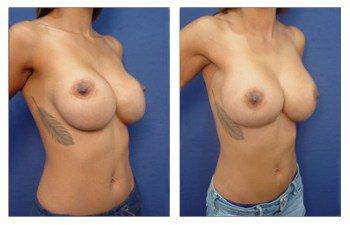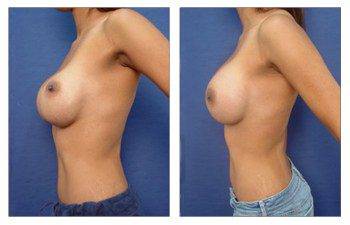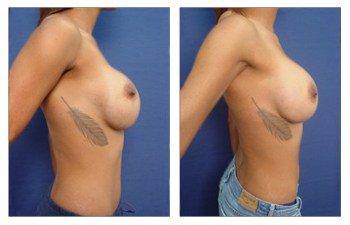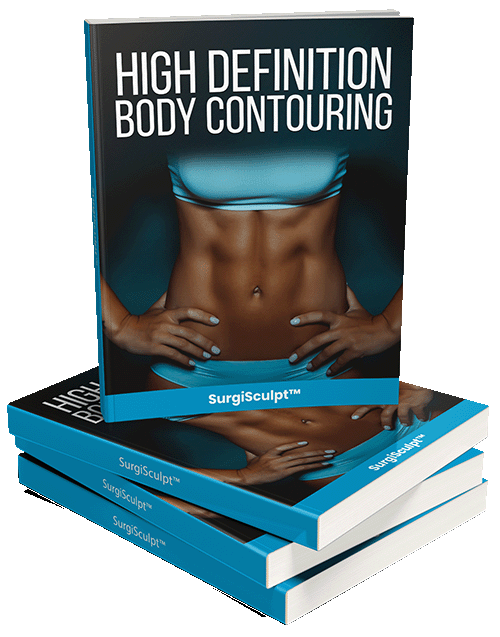




Introduction: Treatment of Bottoming Out Following Breast Augmentation
Bottoming out of the breasts describes an undesirable increase of the lower breast pole prominence that results following breast augmentation or breast lift with implant augmentation. Bottoming out is characterized by stretching of the lower breast skin and shifting of the breast implant into the lower breast pole with resultant loss of upper pole fullness and the pointing up of the nipple and areola complex.
Bottoming out can occur not only following breast implant augmentation but also following simultaneous breast implant augmentation and lift surgery. Treatment of bottoming out following breast implant can only be designed following evaluation and determination of the cause for the bottoming out.
Timing of breast augmentation bottoming out
Several causes of bottoming out have been identified and are best approached by dividing them into early and late occurrences. Both early and late breast bottoming out is more common than previously established.
Early Breast Bottoming Out
The early bottoming out occurs within six months and is related to surgical error. Early bottoming out has two common causes. The first cause results from choosing an implant that is too large to allow for the nipple and areola complex to be centralized on it. In essence, when this implant is positioned it becomes evident that it is high riding because its lower half won’t fit in the lower half of the breast mound.
As a result, the surgeon will purposely try to lower the inframammary crease. Unfortunately, the integrity of this crease is hard to maintain once the crease has been violated. The second cause of early bottoming out is when the lower breast half of the mound is designed too long when performing the breast lift
Late Breast Bottoming Out
Late breast bottoming out has two main causes. The first is the gradual stretching of the lower breast skin and soft tissues when a generous implant is chosen. Patients may see earlier bottoming out if they are physically active and participate in sports that involve repetitive bouncing of the breasts such as running. A final propensity for late bottoming out is possessing thinned-out breast skin and soft tissues which makes stretching of the breast tissues more likely.
Interestingly, patients who undergo breast lifts are most vulnerable to this complication as the process of performing a breast lift makes the lower breast pole more vulnerable to thinning out.
Highest Risk for Breast Bottoming Out
he most common cause of late bottoming out involves stretching of the lower breast skin that occurs from poor elastin composition of the skin. This is mostly related to your genetics and cannot be altered. The propensity of stretchy skin can sometimes be identified preoperatively resulting in your surgeon more aggressively tightening your lower breast skin during a lift or choosing a smaller, more conservatively sized implant.
If your skin has always felt stretchy, then you may be prone to this side effect. Another propensity for stretchy skin is old age. As we get older, the density of elastin, the recoil protein in our skin density is reduced. In fact, elastin production comes to a halt by the time you are 45 years of age.
Treatment for Breast Bottoming Out
Treatment of bottoming out following breast augmentation requires several maneuvers. A breast augmentation revision may require several maneuvers. This typically includes a wedge excision of your lower breast pole to decrease the length of your lower breast pole thereby eliminating lower breast pole fullness and with an inferior breast pole lift. Another consideration is choosing a smaller implant that is going to decrease the shear weight on your lower breast pole.
A final consideration involves re-establishing your inframammary crease if it has been violated or reinforcing the crease if the lower horizontal incision was not been appropriately repaired using deeper stitches following your initial surgery. If you are interested in the treatment of bottoming out following breast augmentation, we encourage you to make a consultation with a SurgiSculpt surgeon. Now, let us look at bottoming out in greater detail.
Further considerations for the Treatment of bottoming out following breast augmentation
Bottoming out, a complication following breast augmentation occurs when the breast implant descends lower than the natural breast crease, resulting in an unnatural appearance. Several treatment options are available to address this issue, including breast augmentation revision surgery, implant removal and replacement, and implant pocket adjustment.
Breast augmentation revision surgery involves modifying the breast implant pocket to reposition the implant and fix the bottoming out. However, this option comes with potential risks such as infection, bleeding, and changes in sensation. Implant removal and replacement also provide a solution by replacing the current implant with a smaller or more supportive one. Risks include scarring, implant rupture, and changes in breast shape.
Implant pocket adjustment involves reinforcing the implant pocket to support the implant and prevent further bottoming out. Risks include implant malposition and the need for further revision surgery.
Overall, the treatment of bottoming out following breast augmentation involves weighing the potential consequences and risks of each option to determine the best course of action for the individual patient.
What is implant bottoming out?
mplant bottoming out occurs when breast implants descend too low on the chest, causing the nipple to sit too high on the breast mound. This can result from inadequate tissue support, whereby the natural breast tissue does not provide enough support for the implant. Additionally, implant placement can play a role in bottoming out, with implants positioned too low on the chest contributing to the issue. Skin laxity, or looseness of the skin, can also lead to implant bottoming out.
Large implants can increase the risk of bottoming out, as they place greater strain on the breast tissue and skin. Aging, hormonal changes, breastfeeding, and weight loss can also impact the risk of bottoming out by affecting the integrity of the breast tissue and skin.
To minimize the risk of implant bottoming out, it is important to choose the right implant size and shape that is suitable for the individual’s body type and natural breast tissue. Proper implant placement and support can also help reduce the risk. It is essential to consult with a board-certified plastic surgeon to determine the most suitable options for breast augmentation surgery.
What causes bottoming out?
Bottoming out refers to the situation where a vehicle’s suspension compresses fully, causing the bottom of the vehicle to hit the ground or road surface. This can occur for a variety of reasons, including carrying a heavy load or driving over a large bump or pothole at high speed.
Inadequate or worn-out suspension components, such as shocks or struts, can also contribute to bottoming out. Additionally, lowering a vehicle’s ride height or installing larger wheels and tires can increase the likelihood of bottoming out. Understanding the causes of bottoming out is important for maintaining the vehicle’s performance and safety, as well as preventing damage to the suspension system and undercarriage.
Skin integrity
Skin integrity in breast surgery patients can be compromised by several factors. Limited skin elasticity, natural breast ptosis or laxity, breast lift mastopexy, and breastfeeding can all contribute to poor skin integrity. Patients with these factors may experience difficulty in supporting the weight of breast implants, which can increase the risk of bottoming-out.
Bottoming-out occurs when the implants descend below the desired position due to inadequate skin support. This can result in a droopy appearance and require corrective surgery. To address poor skin integrity in breast surgery, proper patient selection, preoperative assessment, and surgical planning are essential. Surgeons must carefully evaluate the patient’s skin quality and elasticity to determine the most appropriate surgical approach and implant size.
Measures to address poor skin integrity may include modifying the surgical technique to provide additional support, such as using internal sutures or supportive materials. Patients with poor skin integrity may also benefit from smaller implants or a combined breast lift to improve the overall aesthetic outcome. By considering these factors and taking appropriate measures, surgeons can mitigate the risk of bottoming-out and achieve better outcomes for breast surgery patients.
Implant Size
Choosing the appropriate implant size is crucial in achieving a natural and proportionate look while minimizing the risk of complications such as bottoming out. It’s important to consider your body frame and breast tissue when selecting an implant size, as an implant that is too large for your frame can put pressure on the lower pole of the breast, increasing the chances of bottoming out.
Consulting with your surgeon is essential in determining the right implant size for your body. Your surgeon will assess your body frame, breast tissue, and desired outcome to recommend the most suitable implant size that will minimize the risk of complications.
A heavier implant can also contribute to bottoming out, as the added weight puts more pressure on the lower pole of the breast. This is why it’s crucial to carefully consider the size and weight of the implant in relation to your body frame and breast tissue to achieve the best possible outcome.
In conclusion, selecting the right implant size is a critical decision that should be made in consultation with your surgeon. By considering your body frame, breast tissue, and the potential impact of implant weight on bottoming out, you can minimize the risk of complications and achieve a natural, proportionate result.
Implant Shell
The implant shell plays a significant role in breast augmentation as it directly affects patient safety. The shell of the implant serves as a barrier that contains the silicone or saline filling, and its integrity is crucial in preventing leakage or rupture. A strong and durable implant shell is essential in ensuring the longevity and safety of the implant for the patient.
In recent years, there has been a shift away from textured implants to smooth implants with a “nano-textured” surface like Motiva Implants. This shift is driven by the growing concern over the association of textured implants with a rare type of cancer called Breast Implant-Associated Anaplastic Large Cell Lymphoma (BIA-ALCL). The use of smooth implants with a nano-textured surface, such as Motiva Implants, is believed to minimize the risk of developing BIA-ALCL while providing increased stability and a more natural look and feel.
The benefits of using these new-generation implants include the reduced risk of bottoming out, where the implant drops too low on the chest, as well as a minimized risk of developing BIA-ALCL. The improved stability and safety features of these implants contribute to better patient outcomes and satisfaction.
In conclusion, the implant shell is crucial in ensuring patient safety in breast augmentation, and the shift towards smooth implants with a nano-textured surface like Motiva Implants reflects a commitment to minimizing risks and providing better outcomes for patients.
Implant Placement
ubmuscular implant placement is crucial in preventing bottoming out, as it provides additional support and coverage for the implant. Placing the implant under the pectoral muscle helps to distribute the weight of the implant more evenly, reducing the risk of bottoming out, where the implant descends below the natural crease of the breast. In contrast, placing the implant on top of the muscle can lead to increased tension on the skin and tissue, increasing the likelihood of bottoming out.
When choosing the appropriate implant size, it is important to consider the impact on bottoming out. Larger implants can put more strain on the surrounding tissue, increasing the risk of bottoming out. It is crucial to discuss with the patient their desired size and consider the natural anatomical proportions to minimize the risk.
In summary, submuscular implant placement under the pectoral muscle is essential in preventing bottoming out and reducing the risk of complications. Careful consideration of implant size and placement is key to achieving successful and long-lasting results.
Who is more prone to implant bottoming out?
Implant bottoming out is a condition that occurs when breast implants descend below the natural breast crease, resulting in an unnatural appearance. Various factors can contribute to this issue, and certain individuals may be more prone to experiencing implant bottoming out. Understanding who is at a higher risk for this complication is important for both patients and medical professionals alike, as it can help inform pre-surgical decision-making and post-operative care.
Mastopexy Patients
Patients considering mastopexy, also known as a breast lift, should be aware of the potential risks and considerations involved, especially if they are also considering simultaneous augmentation mammoplasty.
One consideration is the increased risk of bottoming out when combining mastopexy with augmentation. Bottoming-out occurs when the breast implant descends below its original position, leading to a lower breast fold and an unnatural appearance. To minimize this risk, it is often recommended to consider a two-stage procedure, first performing the mastopexy and allowing the breasts to heal before placing implants in a separate surgery. This allows the breasts to fully heal and settle into their new shape before adding the additional weight and volume of breast implants.
Allowing the breasts to heal before placing implants also allows the surgeon to accurately assess and address any changes in breast shape and position that may occur during the healing process. This can result in better long-term outcomes and overall patient satisfaction with the results of the mastopexy and augmentation. Patients need to discuss these considerations with their surgeon and carefully consider the best approach for achieving their desired results.
Hobbies and Activities
Engaging in high-impact activities such as running, jumping, or vigorous exercise can contribute to breast implant displacement. It is crucial to wear a strong, supportive bra during these activities to minimize the risk. Similarly, activities that involve repetitive arm movements, such as weightlifting or tennis, can also impact implant position. Following your surgeon’s recommendations for proper breast support is essential to reduce the risk of displacement.
Risk factors for implant displacement also include improper implant placement, excessive scarring, and certain post-operative complications. It is important to always follow your surgeon’s instructions for proper breast support to minimize these risks.
Treatment options for bottoming out (displacement) may include implant exchange or capsulorrhaphy to correct the positioning of the implants. When considering breast implants, it’s important to understand the differences between saline and silicone implants. Saline implants are filled with a saltwater solution and tend to have a firmer feel, while silicone implants are filled with a cohesive silicone gel and have a more natural feel. It’s crucial to consider these differences when making an informed decision about your implants.
Breast Implant Bottom Out Signs
When considering breast augmentation surgery, it is important to be aware of potential complications that may arise post-surgery. One such complication is breast implant bottoming out, which occurs when the implant shifts downward, causing the nipple to appear higher on the breast. It is important to be able to recognize the signs of bottoming out so that corrective measures can be taken.
In this article, we will discuss the common signs of breast implant bottoming out, including changes in breast shape, asymmetry, and the feeling of the implant sitting lower on the chest. Understanding these signs can help you identify if you are experiencing bottoming out and seek appropriate treatment with your plastic surgeon.
1: Pain and Discomfort
I have been experiencing sharp pain and discomfort in the lower chest area, particularly when breathing deeply or moving in certain ways. I also feel occasional pressure and stretching sensations in the same area. The pain has been persistent and more intense than usual, especially when I try to bend over or lift heavy objects.
I am concerned about the prolonged duration of this pain and discomfort, and I understand the importance of seeking immediate advice from my surgeon. I also want to share that the pain has been affecting my daily activities and I am finding it difficult to perform simple tasks without feeling discomfort in my lower chest.
I will make sure to communicate these symptoms to my surgeon as soon as possible and seek their guidance on how to manage this pain and discomfort effectively. I understand the significance of addressing this issue promptly to ensure my well-being and prevent any further complications.
2: Double Bubble Deformity
Double bubble deformity after breast augmentation can be corrected through surgical intervention. The procedure typically involves releasing the constricted tissue causing the double bubble effect, repositioning the implant, and possibly using a supportive mesh or internal bra to provide additional support. Potential complications may include asymmetry, loss of sensation, and implant displacement.
It is crucial to seek a board-certified cosmetic or plastic surgeon for the correction of double bubble deformity after breast augmentation. Board-certified surgeons have undergone extensive training and are held to high standards of safety and ethics. They have a deep understanding of the anatomy and aesthetics of the breast, making them more equipped to address such complications with precision and expertise. By choosing a board-certified breast surgeon, patients can have confidence in the quality of care and the likelihood of achieving optimal results.
3: Volume Loss in the Upper Breast
Volume loss in the upper breast can be caused by various factors including aging, significant weight loss, pregnancy, or breastfeeding. This can lead to a flattened or deflated appearance in the upper portion of the breast, as well as bottoming out, where the breast implants descend below the natural crease of the breast. Symptoms may include a lack of fullness in the upper breast, visible stretching or thinning of the skin, and nipples that appear too high on the breast mound.
Experienced plastic surgeons like Dr. Koch may use advanced techniques to correct volume loss in the upper breast. One common approach is breast revision surgery, which involves adjusting the position or size of the implants and reshaping the breast tissue to restore natural fullness. In some cases, synthetic mesh scaffolds can be used to provide additional support and help prevent bottoming out. Additionally, a breast lift surgery may be recommended to reposition the breasts and create a more youthful and lifted appearance.
By utilizing these techniques, skilled plastic surgeons can effectively address volume loss in the upper breast and achieve natural-looking results for their patients.
4: Rising Inframammary Scar
If you are dealing with a rising inframammary scar, it is important to consult with a plastic surgeon to determine the best treatment option. Your surgeon may recommend scar massage, topical treatments, or scar revision surgery, depending on the severity and location of the scar. It is essential to closely follow post-operative care instructions to ensure optimal healing and minimize the risk of developing a raised scar. This may include keeping the area clean and dry, taking prescribed medications, and avoiding activities that may put strain on the scar.
By following these instructions, you can help the scar heal properly and reduce the likelihood of it becoming raised. Optimal healing is crucial for minimizing the appearance of the scar and achieving the best possible outcome. Consulting with a skilled plastic surgeon and following their post-operative care instructions can help you address and improve the appearance of your rising inframammary scar.
5: Upward Pointing Nipples
When pressure is applied to the lower breast tissue, it can cause the implants to shift downwards, which in turn can result in upward-pointing nipples. The pressure on the lower breast tissue forces the implants to move lower, and as a result, the nipples are pulled upwards. This can create an unnatural and visually unappealing appearance.
Visually, upward-pointing nipples may appear higher on the breast with a more exaggerated angle than normal. The nipples may also appear to be disproportionately elevated in comparison to the rest of the breast.
The potential causes of this condition could include overly tight bras or clothing putting pressure on the lower breast tissue, as well as the weight of implants causing them to shift downwards. In some cases, improper placement of the implants during surgery could also be a contributing factor.
It is important for individuals experiencing this issue to consult with a qualified healthcare professional or plastic surgeon to determine the cause and explore potential solutions to correct the position of the nipples and achieve a more natural appearance.
Bottoming Out vs Breast Sagging – Key Differences
Bottoming out and breast sagging are two distinct conditions that affect the appearance of the breast.
Bottoming out is characterized by the implant descending below the natural breast crease, resulting in a low position of the nipple relative to the breast mound. This can be caused by factors such as oversized implants, poor surgical technique, or decreased tissue support. On the other hand, breast sagging, also known as ptosis, is a natural result of aging, pregnancy, weight fluctuations, or genetics. It is defined by the downward displacement of the breast tissue, leading to a lower nipple position and a loss of breast firmness.
In terms of appearance, bottoming out tends to create a more noticeable bulge at the lower portion of the breast, while breast sagging results in a more gradual droop of the entire breast. Additionally, in bottoming out, the nipple may appear unnaturally high on the breast mound, whereas in breast sagging, the nipple typically points downwards.
Understanding the differences in characteristics and causes is crucial for accurate diagnosis and treatment. In both cases, consulting with a qualified healthcare professional is essential for proper evaluation and management.
Conclusion: Treatment of Bottoming Out Following Breast Augmentation
Bottoming out following breast augmentation can be treated through revision surgery, which may involve adjusting the position of the implants and reinforcing the supportive tissues. Other treatment options include using specialized support garments and performing exercises to strengthen the chest muscles.
To prevent bottoming out, it is important for the surgeon to carefully assess the patient’s anatomy and choose the appropriate implant size and placement technique. Proper post-surgery care, including avoiding strenuous activities and following the surgeon’s instructions for support garment use, can also help prevent bottoming out.
Risk factors for bottoming out include large implant size, inadequate tissue support, and improper surgical technique. Patients with thin breast tissue and those who engage in activities that put strain on the chest muscles may be at higher risk.
Proper post-surgery care is crucial in preventing and addressing bottoming out. It is important for patients to follow their surgeon’s instructions for activity limitations, support garment use, and any recommended exercises to support the implants and maintain optimal tissue integrity. Regular follow-up appointments with the surgeon are also vital for monitoring the implants and addressing any concerns early on.
